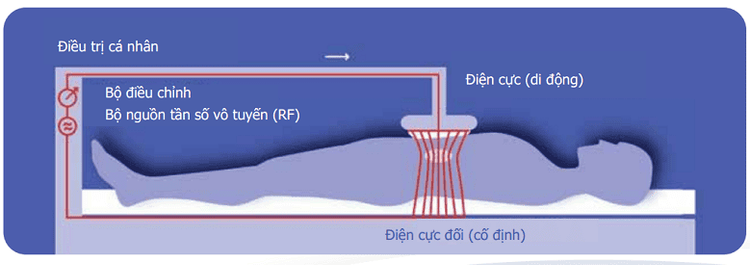This is an automatically translated article.
Studies have shown that elevated body temperature at high temperatures can damage and kill cancer cells while almost causing minimal damage to cells and tissues. normal. With hyperthermia therapy combined with radiation therapy, chemotherapy will give an excellent cancer treatment result for many different types of cancer.1. Hyperthermia What is cancer treatment?
Hyperthermia or heat therapy is a type of cancer treatment through which body tissue is exposed to high temperatures (up to 113°F or 45°C). Research has shown that high temperatures can damage and kill cancer cells, often causing minimal damage to normal tissues. By killing cancer cells and damaging proteins and structures inside the cells, hyperthermia can reduce tumors.Heat therapy is almost always used along with other cancer treatments, such as radiation and chemotherapy. Hyperthermia therapy can increase the sensitivity of some cancer cells to radiation or damage other cancer cells that radiation cannot destroy. When hyperthermia is combined with radiation therapy, they are usually given about an hour apart. Heat therapy can also improve the effects of some cancer drugs.
Many clinical studies have been done to study hyperthermia in combination with radiotherapy or chemotherapy. These studies focus on the treatment of different types of cancer, including sarcoma, melanoma and cancers of the head and neck, brain, lung, esophagus, breast, bladder, rectum, liver, and intestines. excess, cervical and peritoneal (mesothelioma).
Many of these studies, though not all, have shown a significant reduction in tumor size when hyperthermia is combined with other treatments. However, not all of these studies have shown an increase in survival in cancer patients receiving combination therapy.

2. Methods of hyperthermia for cancer treatment
Currently, there are three main methods of hyperthermia therapy in cancer treatment: local, regional and whole-body hyperthermia, depending on the extent of the area being treated.2.1.Local hyperthermia Localized hyperthermia therapy is used to heat a small area, such as a tumor. Very high temperatures are used to kill cancer cells and damage nearby blood vessels. And, as with cooking, the higher the temperature and exposure time, the greater the effect seen in tissues. Thermal ablation includes treatments in which very high temperatures cause irreversible damage to cells while smaller increases in temperature result in mild hyperthermia. Radio waves, microwaves, ultrasonic waves, and other forms of energy can be used to heat the area. When ultrasound is used, the technique is called high-intensity focused ultrasound, or HIFU, sometimes it's also called focused ultrasound.
Hyperthermia can be applied in different ways:
High-energy waves target a tumor near the surface of the body from a machine outside the body. A thin needle or probe is inserted right into the tumor. The tip of the transducer releases energy, heating the tissues around it. Localized hyperthermia can have side effects such as local pain, infection, bleeding, clotting, swelling, burns, blistering, and damage to the skin, muscles, and nerves near the treated area.
2.2.Regional Hyperthermia In regional hyperthermia, a part of the body, such as an organ, limb, or body cavity (a hollow space in the body) will be heated. This method is not hot enough to completely kill cancer cells. And it is often combined with chemotherapy or radiation.
Trắc nghiệm: Thử hiểu biết của bạn về bệnh ung thư
Ung thư là nguyên nhân gây tử vong hàng thứ 2 trên thế giới. Thử sức cùng bài trắc nghiệm sau đây sẽ giúp bạn có thêm kiến thức về yếu tố nguy cơ cũng như cách phòng ngừa bệnh ung thư.
Bài dịch từ: webmd.com
2.3.Hyperthermia Whole body heating is being studied as a way to make chemotherapy work better in treating cancer that has spread (metastatic cancer). The patient's body temperature can be raised by using a heating blanket, a warm bath (putting the patient in warm water), or a heating chamber (like a large incubator). Patients with systemic hyperthermia are sometimes given sedation (medicine to make them feel calm and drowsy) or even light anesthesia. With experience, improved technology, and good skill The use of hyperthermia for cancer treatment has resulted in fewer side effects. In most cases, the problems people have with hyperthermia are not serious.
3. Mechanism of hyperthermia for cancer treatment

It is important to raise the body temperature above 36 degrees Celsius so that the body can improve the immune system against cancer. According to recent studies, human immune function increases by 40% when raising body temperature by 1 degree Celsius. Then the body will be able to fight off a large part of cancer with this effect alone. . The strength of the immune system is very important in the progress of cancer treatment and leads to remarkable results.
Many people know that cancer cells are very sensitive to heat. That is why heat therapy that heats the body outside is so effective. Because blood flow in hard tumors is slow, it can be easier to raise the temperature inside the tumor. The normal environment around tumors has a thermoregulatory function, their temperature will not rise as much as cancer cells. This will result in a temperature gap between the cancer cells and the normal cells.
When the tumor lies at a temperature of 42 degrees Celsius, it becomes immobile. However, because a normal cell's temperature is limited up to 40 degrees Celsius due to the cooling effect of the blood flow, they will not be affected like tumor cells.
Because the cells in the tumor do not have enough blood vessels, they are not regulated by the autonomic nervous system. Therefore, they do not have enough blood flow, they will produce lactic acid and stay in an acidic state. As cells become more acidic, they become more sensitive to heat. Therefore, when the temperature rises above 42 degrees Celsius, cancer cells are more likely to die naturally.
When performing hyperthermia therapy, they will strengthen the body's immune system. Since the body temperature of most cancer patients is below 36 degrees Celsius, they need to be hyperthermic to improve their immune system.
In addition, cancer cells are easily damaged by heat, so heat therapy can both kill cancer cells and improve the immune system.
Cancer cells are easily damaged by high temperatures. Although normal cells can withstand temperatures up to 47 degrees Celsius, cancer cells can only withstand heat up to 42 degrees Celsius. By looking at the characteristics of even normal cells and cancer cells, different methods have been used to treat cancer, such as washing the peritoneum with warm water after cancer surgery.
There have been many reports of cancer sites being cured after a high fever. In addition, one-third of people with cancer are cured spontaneously when experiencing symptoms of high fever.
Currently, Vinmec Times City International General Hospital has been equipped with a thermotherapy machine (Pyrexa) to apply thermotherapy (area and regional) in combination with radiation and chemotherapy. Initial results showed very positive results, the patient had almost no additional side effects when combining heat therapy with radiation therapy as well as chemotherapy and immunotherapy.
Customers can go directly to Vinmec Times City to visit or contact hotline 0243 9743 556 for support.
Article referenced source: cancer.gov
MORE:
How to cure cancer with thermotherapy? Hyperthermia or thermotherapy in the treatment of cancer At what temperature do cancer cells die?













